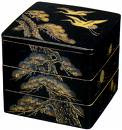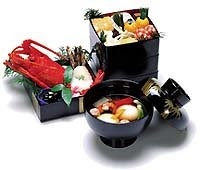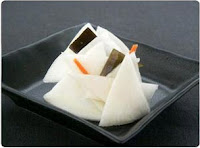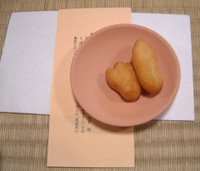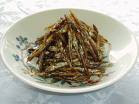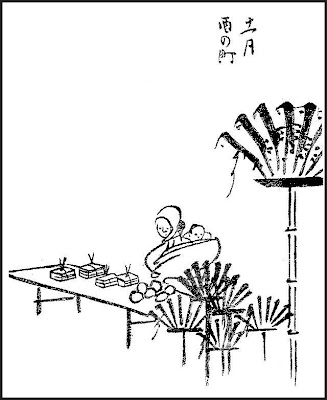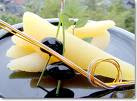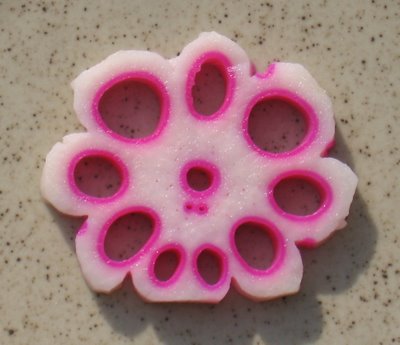::::::::::::::::::::::::::::::::::::::::::::::::::::::::::::::::::::::::::::::::::::::::::::::::::::
The Japanese Food Saijiki
和食歳時記
:::::::::::::::::::::::::::::::::::::::::::::::::::::::::::::::::::::::::::::::::::::::::::::::::::::
Winter Food
***** Location: Japan
***** Season: Winter
***** Category: Humanity
*****************************
Explanation
The Haiku Winter begins on November 7, according to the Asian lunar calendar.

There are many food specialities for WINTER in Japan.
In Alphabetical order of the Japanese.
Use your browser to find a word, please !
If the name of a vegetable is mentioned, it represents the cooked form as it is served with rice.
For many fish, see
World Kigo Database: Fish as Kigo
Mochi, ricecakes for the New Year, are prepared in winter.
Salting fish to keep for winter is common in many areas.
Shiru, soups and broth are a fare for winter.
Check the words with ..jiru for that.
Stew, nabe, is also a favorite in this season. Since Buddhists were not allowed to eat meat, the names for meat stews are mostly taken from flowers !
:::::::::::::::::::::::::::::::::::::::::::::::::::::::::::::::::::::::::::::::::::::::::::::::::::
Early Winter

kawabitarimochi 川浸り餅(かわびたりもち)
mochi prepared on the day of kawabitari
first day of the 12th lunar month
they are an offering to the god of water and are thrown into the river.
People who had to traverse a dangerous river crossing also ate them to ensure a safe crossing.
川渡り餅。乙子(おとご)餅。かびたれもち. 川浸餠
also called
otogomochi otogo mochi 乙子餅
"mochi for the youngest child"
To pray for the health of the joungest child in the family.
On the first day of the 12th lunar month, ceremonies for the deity of water were held, and sometimes people would expose their backside and dip it in water (shiribitari) to pray for safety against water accidents like drowning.
This ritual is reflected in the kigo
otogo no tsuitachi 乙子の朔日 (おとごのついたち)
otogo no sekku 乙子の節句(おとごのせっく)
seasonal festival of the youngest child
The last lunar month was also called roogetsu 蝋月(ろうげつ) or
otogozuki 乙子月
ROO is an old Chinese word for hunting, and the flower of this month is the fragrant roobai 蝋梅 forsythia.
. okotohajime, o koto hajime お事始め "begin of work"
more ceremonies on the first day of the 12th lunar month
:::::::::::::::::::::::::::::::::::::::::::::::::::::::::::::::::::::::::::::::::::::::::::::::::::
Mid-Winter
Araremochi 霰餅 (あられもち)
rice-cake cubes, mochi crunch
kakimochi 欠餅(かきもち)
CLICK here for Photos !
Christmas cake クリスマス ケーキーkurisumasu keeki and Christmas in general
Weihnachtskuchen, Kuchen und Gebäck für Weihnachten
. . . CLICK here for Photos of the japaneses version with strawberries !
Weihnachtsstollen, Stollen
Weihnachtsplätzchen
Kayu ... Rice Gruel
Rice gruel (kayu) with many kigo for the New Year
Mochikubari 餅配 (もちくばり)
giving mochi to the neighbours
配り餅(くばりもち)
Mochitsuki 餅搗 (もちつき)
Pounding Rice (mochi tsuki) for ricecakes
song while pounding ricecakes mochitsuki uta 餅搗唄(もちつきうた)、chinmochi 賃餅(ちんもち)、maschine to prepare mochi, mochitsuki-ki 餅搗機(もちつきき)、straw mat to place the mochi, mochi mushiro 餅筵(もちむしろ)、 sound of pounding mochi, mochi no oto 餅の音(もちのおと) , pounding mochi in the cold, kantsuki 寒搗 (かんつき)
Toshikoshi Soba ... 年越しそば Buckwheat noodles on the last day of the year
:::::::::::::::::::::::::::::::::::::::::::::::::::::::::::::::::::::::::::::::::::::::::::::::::::
Late Winter
Kanmochi 寒餅 (かんもち) "mochi in the cold"
kan no mochi 寒の餅(かんのもち)
kanmochi tsuku, preparing kanmochi 寒餅搗く(かんもちつく)
Kantamago 寒卵 (かんたまご)
eggs layed in the cold season
..... kan tamago 寒玉子(かんたまご)
They are known to be especially nutritious and healthy.
Kanten tsukuru 寒天造る (かんてんつくる)
preparing kanten agar
kanten seisu 寒天製す(かんてんせいす), kanten sarasu 寒天晒す(かんてんさらす)
drying kanten, kanten hosu 寒天干す(かんてんほす)
Kanten agar and other seaweeds
Kanten and tokoroten agar jelly as SUMMER food
Kanzarashi 寒晒 (かんざらし, 寒晒し)
grain exposed to the cold
寒曝(かんざらし)、寒晒粉(かんざらしこ)
Koorimochi 氷餅(こおりもち) "ice mochi", frozen mochi
koorimochi tsukuru 氷餅造る (こおりもちつくる)
Konyaku koorasu 蒟蒻氷らす (こんにゃくこおらす)
freezing devil's tongue root jelly
konyaku koorasu 蒟蒻凍らす(こんにゃくこおらす)、
koori konyaku 氷蒟蒻(こおりこんにゃく)
preparing frozen konyaku, koorikonyaku tsukuru
氷蒟蒻造る(こおりこんにゃくつくる)
konnyaku こんにゃく food ... gelatinous food made from devil's-tongue starch
Konnyaku and Matsuo Basho
CLICK here for KONYAKU Photos !
Mizumochi 水餅 (みずもち) "water mochi"
rice cakes in jelly form
making mizumochi, mizumochi tsukuru
水餅造る(みずもちつくる)
CLICK here for Photos !
Shimidoofu tsukuru 凍豆腐造る (しみどうふつくる)
preparing freezing tofu , 凍り豆腐

itedoofu 晩冬 凍豆腐(いてどうふ)、koori doofu 氷豆腐(こおりどうふ)、kandoofu 寒豆腐(かんどうふ)、Kooyadoofu, Koya Tofu 高野豆腐(こうやどうふ)、
freezing tofu, toofu koorasu 豆腐氷らす(とうふこおらす)
- Reference : Koyadofu
. Koyasan 高野山 and Kobo Daishi Kukai .
Shin nori 新海苔 (しんのり) new nori seaweed
hatsunori, first nori 初海苔(はつのり)
Seaweed (kaisoo) Japan
Including laver (nori), kelp (wakame), duckweed (mo) and agar agar (tengusa)
:::::::::::::::::::::::::::::::::::::::::::::::::::::::::::::::::::::::::::::::::::::::::::::::::::
All Winter
Ankoonabe 鮟鱇鍋 (あんこうなべ) angler fish stew
ankoojiru soup 鮟鱇汁(あんこうじる)
ankoo 鮟鱇 (あんこう) anglerfish, goosefish, mankfish
and more ankoo kigo
:::::::::::::::::::::::::::::::::::::::::::::::::::::::::::::::::::::::::::::::::::::::::::::::::::::
Botannabe 牡丹鍋 (ぼたんなべ) Wild boar stew
lit. "peony stew".
shishinabe 猪鍋(ししなべ)、inoshishinabe いのしし鍋(いのししなべ)、yamakujira 山鯨(やまくじら)
Wild Boar, Inoshishi and Haiku
Meat from the Mountains
:::::::::::::::::::::::::::::::::::::::::::::::::::::::::::::::::::::::::::::::::::::::::::::::::::::
Chirinabe ちり鍋 (ちりなべ) stew with small fish pieces
taichiri 鯛ちり(たいちり)、tarachiri 鱈ちり(たらちり)
:::::::::::::::::::::::::::::::::::::::::::::::::::::::::::::::::::::::::::::::::::::::::::::::::::::
Dongarajiru 寒鱈汁(どんがら汁) with cod fish, speciality of Yamagata
:::::::::::::::::::::::::::::::::::::::::::::::::::::::::::::::::::::::::::::::::::::::::::::::::::::
Fugujiru, fugu jiru 河豚汁 (ふぐじる) Blowfish soup
fugutojiru ふぐと汁(ふぐとじる)、fugutoojiru ふぐとう汁(ふぐとうじる)
fugunabe, fugu nabe blowfish stew 河豚鍋(ふぐなべ)
fuguchiri 河豚ちり(ふぐちり)、tetsuchiri tetchiriてつちり
fugu no yado, restaurant that serves fugunabe
河豚の宿(ふぐのやど)
Blowfish, globe fish (fugu)
Fukashimeshi 蒸飯 (ふかしめし) steamed warm rice
mushimeshi 蒸し飯(むしめし)、nukumemeshi 温め飯(ぬくめめし)、 meshi fukashi 飯ふかし(めしふかし)、gohan mushi ご飯蒸(ごはんむし)、 gozen mushi ご膳蒸(ごぜんむし)
Furofuki , radish in broth ... 風呂吹き
fuyuna meshi 冬菜飯(ふゆなめし)
cooked rice with leafy winter vegetables
:::::::::::::::::::::::::::::::::::::::::::::::::::::::::::::::::::::::::::::::::::::::::::::::::::::
Hoshinajiru 干菜汁 (ほしなじる)
soup from dried leafy vegetables
hibajiru 干葉汁(ひばじる)
:::::::::::::::::::::::::::::::::::::::::::::::::::::::::::::::::::::::::::::::::::::::::::::::::::::
Imagawa yaki 今川焼 (いまがわやき, 今川焼き)
kind of waffles filled with sweat red bean paste
Made from wheat, eggs, sugar and water for the dough.
Custard cream or white bean paste is also used for filling. The two sides of the waffle are grilled separately. This sweet has different names in various area of Japan.

taikoyaki 太鼓焼(たいこやき), tomoeyaki 巴焼(ともえやき)、 gishiyaki 義士焼(ぎしやき)
store to make Imagawa yaki, imagawayakiya 今川焼屋(いまがわやきや)
Imagawayaki began to be sold near the Kanda Imagawabashi bridge during An'ei years (1772 - 1781) in the Edo period. The name of Imagawayaki originates from this time.
The bridge had been built by Imagawa Zen-Saemon 今川善右衛門.
Other names (not listed as kigo) are Oobanyaki 大判焼き (like an Oban piece of gold coin), 二重焼き (double grilled), 回転焼き (turned-around waffle), kintsuba きんつば, amatarooyaki 甘太郎焼, fuufu manjuu 夫婦まんじゅう(フーマン) for a good couple, ajiman あじまん, GI焼き and more.
taiyaki たい焼き in the form of a sea bream is a kind of Imagawa-yaki.
まよい焼き, filled with cheese, egg or even a meat burger between the two waffles.

A shrine for Imagawa Yaki ! 今川焼 神社
Imagawayaki began to be sold near the Kanda Imagawabashi bridge during An'ei years (1772 - 1781) in the Edo period. The name of Imagawayaki originates from this time.
© More in the WIKIPEDIA !
Imagawa-yaki HAIKU by Kusumoto Kenkichi
- - - - -
Imogayu 藷粥 (いもがゆ)
rice porridge with sweat potatoes
often the daily fare of poor farmers in the Edo period.
:::::::::::::::::::::::::::::::::::::::::::::::::::::::::::::::::::::::::::::::::::::::::::::::::::::
Jibu (じぶ), Kagani 加賀煮(かがに)dish from the Kaga area
jibuni 治部煮(じぶに)、jibunabe じぶ鍋(じぶなべ)
with chicken and duck pieces
CLICK here for Photos !
Jingiskan nabe 成吉思汗鍋 (じんぎすかんなべ)
"Genghis Khan Stew"
Mongolian Mutton stew
ジンギスカン鍋(じんぎすかんなべ)
成吉思汗料理(じんぎすかんりょうり)
CLICK here for Photos of the hot plate !
jiru, shiru ... soup, broth .. 汁
:::::::::::::::::::::::::::::::::::::::::::::::::::::::::::::::::::::::::::::::::::::::::::::::::::::
Kaburajiru 蕪汁 (かぶらじる) turnip soup
daikojiru 大根汁(だいこじる)
kaburazushi 蕪鮓 (かぶらずし) sushi with turnips
simmered turnips, kabura mushi 蕪蒸 (かぶらむし)
Kaiyaki 貝焼 (かいやき) simmering seafood in shells
kayaki かやき
CLICK here for Photos !
Kama-age udon 釜揚饂飩 (かまあげうどん)
udon noodles in broth
kama-age 釜揚(かまあげ)
Kasujiru 粕汁 (かすじる) sake-lees soup
sake no kasu 酒の粕(さけのかす)
Kenchinjiru 巻繊汁 (けんちんじる)
Vegetable Chowder from Yamanashi
kenchin けんちん
Kinmedai 金目鯛 (きんめだい) Alfonsino fish, Beryx splendens
Komaijiru 氷下魚汁(こまいじる)soup with saffron cod
Konowata 海鼠腸 (このわた)
salted entrails of the sea cucumber
sake with salted entrails, konowatazake 海鼠腸酒(このわたざけ)
koorani 甲羅煮 (こうらに)
simmering in the shells of seafood
koora mushi 甲羅蒸し(こうらむし)
especially with kani crabs.
Kujiranabe 鯨鍋 (くじらなべ) whale meat stew
kujirajiru soup, kujirajiru 鯨汁(くじらじる)
Kukizuke 茎漬 (くきづけ, 茎漬け) vegetable stalk pickles
leaf pickles, nazuke 菜漬(なづけ)、hazuke 葉漬(はづけ)、aozuke 青漬(あおづけ)、
furuzuke 古漬(ふるづけ)、Pickles from Omi area, oomi zuke 近江漬(おうみづけ)
kaomise guki 顔見世茎(かおみせぐき)、
barrel for preparing pickles, kuki no oke 茎の桶(くきのおけ)
stone for the lid of the barrel, kuki no ishi 茎の石(くきのいし)
water for the pickles, kuki no mizu 茎の水(くきのみず)
pressing the stems and stalks, kuki osu 茎圧す(くきおす)
Kumowata 雲腸 (くもわた) soft fish roe "like clouds"
菊腸(きくわた)、kiku shirako 菊白子(きくしらこ)、kowawata 強腸(こわわた)、 minowata 蓑腸(みのわた)
kusuri gui .. 薬喰 .. "eating medicine food"
"seller of deer horn", roku uri 鹿売(ろくうり)
"food for the cold season" kangui 寒喰(かんぐい)
:::::::::::::::::::::::::::::::::::::::::::::::::::::::::::::::::::::::::::::::::::::::::::::::::::::
Misotsuki 味噌搗 (みそつき) preparing miso
miso tsukuru 味噌作る(みそつくる)、味噌焚き(みそたき)、
寒味噌(かんみそ)
Momijinabe 紅葉鍋 (もみじなべ) stew with deer meat
lit. "red leaves stew"
Meat from the Mountains
Mushimanjuu 蒸饅頭 (むしまんじゅう)
steamed red bean-jam bun
sakamanjuu 酒饅頭(さかまんじゅう)、amazake manjuu 甘酒饅頭(あまざけまんじゅう)
steamed buns with meat, nikumanjuu 肉饅頭(にくまんじゅう)
CLICK here for Photos !
Mushizushi 蒸鮓 (むしずし) warmed sushi
nukuzushi ぬく鮓(ぬくずし), nukumezushi ぬくめ鮓(ぬくめずし)、
warm sushi in a pot, chawan zushi 茶碗鮓(ちゃわんずし)
NUKUI is a word to mean "warm" in Western Japan.
CLICK here for Photos !
:::::::::::::::::::::::::::::::::::::::::::::::::::::::::::::::::::::::::::::::::::::::::::::::::::::
Nabeyaki 鍋焼 (なべやき)stew in an earthen pot
with fish, meat and vegetables
nabeyaki udon 鍋焼饂飩(なべやきうどん, 鍋焼きうどん, 鍋焼き饂飩)
CLICK here for Photos !
Natto 納豆 (なっとう) fermented soybeans
vendor of natto, natto uri 納豆売(なっとううり)
Nattojiru, fermented beans in soup 納豆汁 (なっとうじる)
Natto, fermented soybeans and Daruma
Negijiru 葱汁 (ねぎじる) leek soup
leek soup, nebukajiru 根深汁(ねぶかじる)
leek in rice soup, negizoosui 葱雑炊(ねぎぞうすい)
Naganegi 葱 (ねぎ) leek, green onions
Negima 葱鮪 (ねぎま) stew with leek and maguro tuna fish
leek and maguro stew, negima nabe 葱鮪鍋(ねぎまなべ)
tuna fish stew, maguronabe、鮪鍋(まぐろなべ)
WASHOKU
More maguro tuna dishes
Nikogori 煮凝 (にこごり, 煮凝り) jellied fish or meat broth
nikogori 煮凍(にこごり),
jelly of crucian carp, kogoribuna 凝鮒(こごりぶな)
CLICK here for Photos !
.......................................................................
Ninjin, ninjin 人参 (にんじん ) carrot, carrots, Karotten

source : facebook food inc
.......................................................................
Noppeijiru 濃餅汁 (のっぺいじる)
vegetable soup with mochi
noppeijiru のっぺい汁(のっぺいじる)、noppe のっぺ、
nuppei ぬっぺい、noppeni のっぺ煮(のっぺに)
speciality
:::::::::::::::::::::::::::::::::::::::::::::::::::::::::::::::::::::::::::::::::::::::::::::::::::::
Oden hodgepodge stew 。。。 おでん
nikomi oden 煮込みおでん(にこみおでん)、Kanto Oden 関東煮(かんとうだき)
stall serving oden food, odenya おでん屋(おでんや)
:::::::::::::::::::::::::::::::::::::::::::::::::::::::::::::::::::::::::::::::::::::::::::::::::::::
Roosoku yaki 蝋燭焼 (ろうそくやき, 蝋燭焼き) craw's meat
Meat of craws is hashed and mixed with miso paste. It is then rolled to sticks and grilled at the fireplace.
Food of the poor farmers from Shinshu and Northern Japan.

:::::::::::::::::::::::::::::::::::::::::::::::::::::::::::::::::::::::::::::::::::::::::::::::::::::
Sake, Salmon with its winter kigo
ishikarinabe 石狩鍋 (いしかりなべ) stew with salmon
sakenabe 鮭鍋(さけなべ)
karasake 乾鮭 からさけ
hoshizake 干鮭(ほしざけ)
Shiozake 塩鮭 (しおざけ)
新巻(あらまき)、塩引(しおびき)、しおじゃけ
Salmon (sake) Japan
:::::::::::::::::::::::::::::::::::::::::::::::::::::::::::::::::::::::::::::::::::::::::::::::::::::
Sakuranabe 桜鍋 (さくらなべ) stew with horse meat and miso
lit. "cherry blossom stew".
banikusuki 馬肉鋤(ばにくすき)、ketobashi けとばし
CLICK here for Photos !
Sanpeijiru 三平汁 (さんぺいじる)
salty soup with sardines and vegetables
sanpeizara 三平皿(さんぺいざら)
CLICK here for Photos !
Satsumajiru 薩摩汁 (さつまじる) soup with sweet potatoes
Sweet potatoes and Daruma ... satsuma-imo 薩摩芋
Senmai zuke 千枚漬 (せんまいづけ) turnip pickles
A speciality from Kyoto, where the big turnips are finely cut into "1000 slices" and pickled with salt.
CLICK here for Photos !
Seriyaki 芹焼 (せりやき) dropwort stew
dropwort stew with chicken meat, serinabe 芹鍋(せりなべ)
Shinazuke 品漬 (しなづけ) Pickles
from Hida Takayama. Made from eggplants, big radish and a mushroom called nezumidake 鼠茸 (hookidake 箒茸 ).
Also called sunazuke 酢菜漬
CLICK here for Photos !
Shio ... SALT
Salt (shio) and salted winter food
salted salmon, shiozake 塩鮭 (しおざけ) and MANY MORE !
Shioburi 塩鰤 (しおぶり) salted yellowtail fish
Shiodara 塩鱈 (しおだら) salted codfish
Shiogatsuo 塩鰹 (しおがつお) salted bonito
Shoogamiso 生姜味噌 (しょうがみそ) Miso paste with ginger
Shotsurunabe, shottsuru nabe 塩汁鍋 (しょっつるなべ) "salt fish soup stew"
shotsuru 塩汁(しょっつる),
shotsuru kayaki 塩汁貝焼(しょっつるかやき)
with fermented salted hatahata fish sauce, sardines and other seafood
Speciality of Northern Japan.
Hatahata 鰰 ハタハタfrom Akita
Sobagaki 蕎麦掻 (そばがき) buckwheat dumplings
Buckwheat (soba), Buckwheat flowers Japan
Sugiyaki 杉焼 (すぎやき)"preparing food in a cedar box"
hegiyaki 折ぎ焼き
fish, mussles and vegetables are packed in a cedar box and simmered.
Suguki 酢茎 (すぐき) Vinegar vegetable pickles
seller of these pickles, suguki uri 酢茎売(すぐきうり)
Sukiyaki 鋤焼 (すきやき) "food prepared on a spade"
gyuunabe 牛鍋(ぎゅうなべ)、uosuki 魚すき(うおすき)、okisuki 沖すき(おきすき)、torisuki 鶏すき(とりすき)、udonsuki 饂飩すき(うどんすき)
one of the typical winter dishes of Japan !
CLICK here for Photos !
Sunamako 酢海鼠 (すなまこ) sea cucumber in vinegar
Suppon nabe 鼈鍋 (すっぽんなべ) suppon turtle stew
marunage まる鍋(まるなべ, 丸鍋)
suppon zoosui, turtle rice gruel 鼈雑炊(すっぽんぞうすい)
Suppon is a delicacy for the tired workers of Japan.
CLICK here for Photos !
:::::::::::::::::::::::::::::::::::::::::::::::::::::::::::::::::::::::::::::::::::::::::::::::::::::
Tarajiru, 鱈汁(たらじる)soup with tara
tarako, roe of the cod 鱈子(たらこ)
tarachiri, hodgepodge with tara 鱈ちり(たらちり)
hatsu tara 初鱈 (はつたら) first tara of the season
kigo for early winter
Taiyaki 鯛焼 (たいやき, 鯛焼き)
waffles filled with sweat bean paste
in the form of a sea bream (tai).

vendor of these waffles 鯛焼屋(たいやきや)
CLICK here for Photos !
Takuanzuke 沢庵漬 (たくあんづけ)Takuan radish pickles
takuan tsukeru, preparing Takuan radish 大根漬ける(だいこんつける)、新沢庵(しんたくあん)、
新漬沢庵(しんづけたくあん)、早漬沢庵(はやづけたくあん)
Radish (daikon) Japan. Pickled radish, takuan.
Tanukijiru 狸汁 (たぬきじる) Badgers' soup
Food of the poor farmers in many rural areas of Japan.
Badgers and Daruma !
:::::::::::::::::::::::::::::::::::::::::::::::::::::::::::::::::::::::::::::::::::::::::::::::::::::
Yakiimo, yaki-imo 焼薯 (やきいも)
roasted sweet potatoes
vendor of roasted sweet potatoes 焼芋屋(やきいもや)
ishiyakiimo, roasted on hot stones 石焼芋(いしやきいも)
tsuboyakiimo, roasted in a pot 壺焼芋(つぼやきいも)
Saikyoo yaki, from the Kyoto area 西京焼(さいきょうやき)
hokkori ほっこり、
"university potatoes", daigaku imo 大学芋(だいがくいも)
with a sweat syrup cover
Yamijiru 闇汁 (やみじる) "soup in the dark"
soup eaten in the dark with candlelight, shared with good friends. Sometimes they had to guess the kind and number of ingredients in the dark.
yamiyojiru 闇夜汁(やみよじる)
meeting to eat soup in the dark,
yamijiru-e 闇汁会(やみじるえ)
Yosenabe 寄鍋 (よせなべ) mixed stew
The most popular, often with leftovers from the week.
Yotakasoba 夜鷹蕎麦 (よたかそば)
Buckwheat noodles for the late night hawkers.
yonaki soba 夜泣蕎麦(よなきそば)
yonaki udon 夜啼饂飩(よなきうどん)
Yudoofu, tofu in boiling water ... 湯豆腐
..... yuyakko 湯奴
:::::::::::::::::::::::::::::::::::::::::::::::::::::::::::::::::::::::::::::::::::::::::::::::::::::
Zoosui 雑炊 (ぞうすい) rice porridge
(containing vegetables and bits of meat or fish)
a very popular dish for an evening meal. There are many different kinds, according to the main ingredient.
ojiya, おじや、rice soup, rice gruel. Reisbrei
zoosui
with chicken, torizoosui 鶏雑炊(とりぞうすい)
with duck, kamo zoosui 鴨雑炊(かもぞうすい)
with puffer fish, fugu zoosui 河豚雑炊(ふぐぞうすい)
suppon zoosui 鼈雑炊(すっぽんぞうすい)、
ankoo zoosui 鮟鱇雑炊(あんこうぞうすい)
salmon, sake zoosui 鮭雑炊(さけぞうすい)
oysters, kaki zoosui 牡蠣雑炊(かきぞうすい)
crabs, kani zoosui 蟹雑炊 (かにぞうすい)
cod, tara zoosui 鱈雑炊(たらぞうすい)
mochi zoosui 餅雑炊(もちぞうすい)
sweet potatoes, imo zoosui 薯雑炊(いもぞうすい)
leafy vegetables, nazoosui 菜雑炊(なぞうすい)
leek, negi zoosui 葱雑炊(ねぎぞうすい)
nira leek, nira zoosui 韮雑炊(にらぞうすい)
eggs, tamago zoosui 卵雑炊(たまごぞうすい)
with miso base, miso zoosui 味噌雑炊(みそぞうすい)
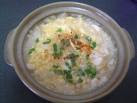
*****************************
Worldwide use
hot cereal, oatmeal, mush, porridge
kigo for all winter
Haferbrei
*****************************
Things found on the way

Daruma Nabe ... だるま鍋 ... Cooking pot and restaurant !
*****************************
HAIKU
*****************************
Related words
***** hot rice wine, atsukan 熱燗, kanzake 燗酒.....
Ricewine, rice wine (sake, saké, saki, Japan)
***** Sweets from Japan (wagashi) 和菓子歳時記
The Japanese Sweets Saijiki
***** . Cheese KIGO from Europe
***** The Asian Lunar Calendar. Reference
NEXT
*********** NEW YEAR FOOD
BACK TO
*********** AUTUMN FOOD
Check the WKD LIST of
. HUMANITY and Winter Kigo
:::::::::::::::::::::::::::::::::::::::::::::::::::::::::::::::::::::::::::::::::::::::::::::::::::
